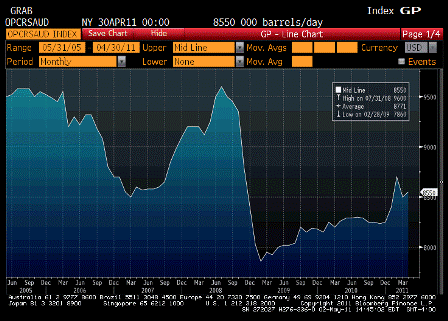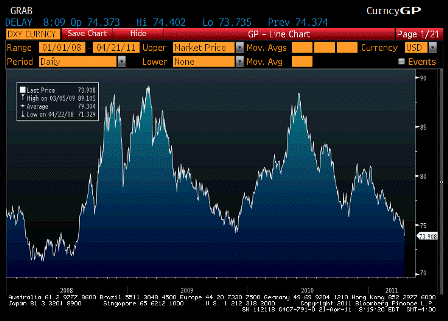Long gold, stocks, and other currencies is all the same trade, and all the specs and trend followers are in big, proving once again that the crowd isn’t always wrong.
Lack of understanding of what QE actually is seems to have scared everyone from portfolio managers and the man on the street to Putin to take action.
And Chairman Bernanke’s recent remarks, though fundamentally sound, gave them no comfort whatsoever, and only encourage this latest round of dollar selling and related trades.
No telling how long it will keep going.
But underneath it all the dollar’s fundamentals aren’t all that bad relative to the other currencies, apart from rising crude prices keeping the US import bill higher than otherwise, though partially offset by higher export prices, including food.
At last look trade gaps look to be ‘deteriorating’ in the eurozone, the UK, Japan, Canada, and Australia, as their currencies continue to climb, indicating they may have gotten past the humps in their J curves and trade flows have turned against them?
So looks to me like with the entire dollar move predominately driven by ‘hot money’ in the broad sense, there is nothing fundamental to get in the way of the reversal scenario suggested at the end of this article.
Best way to play it? Stay out of the way.
By Reuters
April 28 (Bloomberg) — Americans’ cheap money spigot remains open and the flow is as fast as ever, meaning the world had better brace for even higher oil, metals and food prices and a weaker dollar.
The clear message from Federal Reserve Chairman Ben Bernanke on Wednesday was that the U.S. central bank intends to keep interest rates exceptionally low and monetary policy very easy as it continues to try to inflate the U.S. economy back to health.
For investors, he offered further encouragement to keep borrowing in dollars, paying virtually nothing and then swapping those dollars into higher-yielding currencies or using them to buy oil, metals and food futures and options.
This so-called “carry trade” has become the trade du jour, particularly with the dollar’s precipitous drop of around 10 percent from its peak in January.
By comparison, U.S. crude futures are up 23 percent so far this year and the Thomson Reuters-Jefferies CRB index, a global index of commodities, is up 10 percent.
“The biggest risk right now is that Bernanke’s looseness creates the unintended consequence of boom-goes-bust, where easy-money-driven asset bubbles implode and confidence is consequently sucked out of the economy,” said JR Crooks, chief of research at investment advisory firm Black Swan Capital in Palm City, Florida.
“It’s one thing to have a currency on the decline; it’s another thing to have GDP on the decline.”
The “carry” trading tack is akin to the still popular yen-carry trade, which involves borrowing yen at Japan’s near-zero interest rates to purchase other higher-yielding securities such as Treasuries. Investors are borrowing in currencies like the dollar to fund purchases in markets with higher yields or currencies with potentially higher returns.
The Barclays’ G10 carry excess return index shows that borrowing in low-yielding currencies such as the greenback and buying those with high interest rates like the Australian dollar has generated returns of about 37 percent so far since the end of the financial crisis in early 2009.
“The Fed seems to be in no rush to tighten monetary policy. So if rates remain low, why shouldn’t the dollar be the preferred funding currency?” said Thomas Stolper, chief currency strategist at Goldman Sachs in London.
“And as you know in foreign exchange, it’s all about differentials between countries and in that respect, that differential is negative for the dollar,” Stolper added.
The yield differential continues to weigh against the dollar, particularly against the euro , the Australian dollar, and some emerging market currencies, whose central banks have started to raise interest rates.
Record low U.S. rates of zero to 0.25 percent, an enormous supply of liquidity under the Fed’s purchases of more than $2 trillion of Treasury and mortgage bonds, and improving economic prospects in emerging markets have prompted investors to borrow the lower-yielding dollar in carry trades over the last 18 months.
A rough estimate from investment advisory firm Pi Economics in Stamford, Connecticut, showed that the Fed’s easing may have fueled dollar carry trades in excess of $1 trillion, based on U.S. financial institutions’ net foreign assets positions.
On Wednesday, the dollar skidded to a three-year low of 73.284 as measured by the Intercontinental Exchange’s dollar index, down around 10 percent from its peak in January. Many traders expect the index to fall through the all-time low, hit in July 2008, of 70.698.
Feasible Alternative
For some investors, using the dollar in carry trades remains the only feasible alternative to other low-yielding currencies such as the yen and Swiss franc .
While the yen yields an interest rate of zero, like the dollar, the Japanese currency could strengthen if the economy goes into recession. Since Japan has huge overseas investments, a recession would prompt a repatriation of domestic investors’ funds to bolster savings, boosting the yen.
The Swiss economy is in much better shape than the United States and a rise in inflation there could well prompt the Swiss National Bank to raise interest rates, much like the European Central Bank did early this month.
That leaves the U.S. dollar as the only other option left to finance investors’ penchant for risk-taking.
“No one really thinks the Fed will hike rates significantly … They would want to keep rates low since the recovery is not that strong,” said Pablo Frei, a portfolio manager and senior analyst at Quaesta Capital, a Zurich-based fund of funds focused on currency managers, with assets under management of about $3.5 billion.
Frei said that although the dollar is a big short among hedge funds, “people have become more cautious of the risk of the dollar carry,” given how crowded this trade has become.
He added that the fund managers he tracks have reduced their short position on the dollar, although the lower-dollar bet remains their largest exposure.
As in any crowded trade, there is always the risk of a squeeze once things get sour, which could lead to a massive unwinding of carry trades and the potential for huge losses for those slow to get out. When global stocks drop, or when the risk barometer shoots up, investors tend to repatriate funds, close out losing carry trades and buy back currencies they had shorted.
This happened in 2008 during the global financial crisis and could well happen again.



